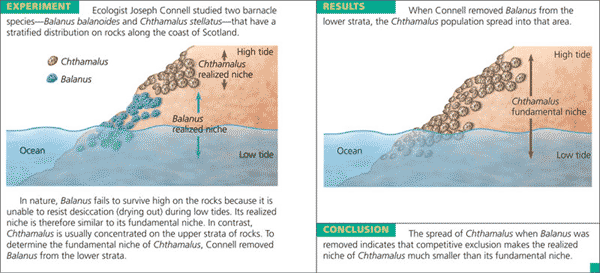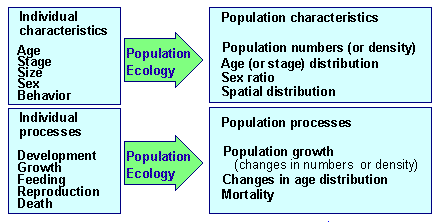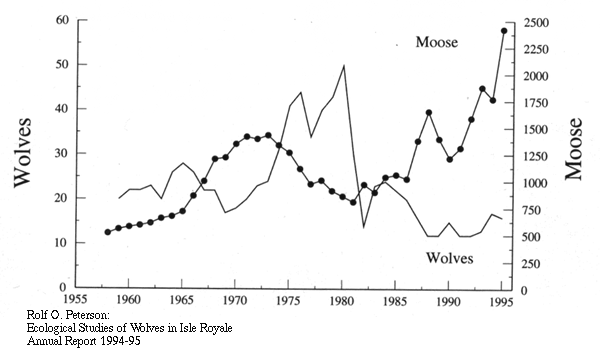topic 2.1: Species and populations

A population is a subset of individuals of one species that occupies a particular geographic area and, in sexually reproducing species, interbreeds. The geographic boundaries of a population are easy to establish for some species but more difficult for others. For example, plants or animals occupying islands have a geographic range defined by the perimeter of the island. In contrast, some species are dispersed across vast expanses, and the boundaries of local populations are more difficult to determine. A continuum exists from closed populations that are geographically isolated from, and lack exchange with, other populations of the same species to open populations that show varying degrees of connectedness.
In this unit we will focus on how species interacts with its abiotic and biotic environments, and its niche is described by these interactions.
This unit will take a minimum of 4.5 hours.
In this unit we will focus on how species interacts with its abiotic and biotic environments, and its niche is described by these interactions.
This unit will take a minimum of 4.5 hours.
Significant Ideas
- A species interacts with its abiotic and biotic environments; its niche is described by these interactions.
- Populations change and respond to interactions with the environment.
- A system has a carrying capacity for a given species.
Big questions:
- What strengths and weaknesses of he systems approach and the use of models have been revealed through this topic?
Knowledge and Understanding
2.1 U1 A species is a group of organisms that share common characteristics and that interbreed to produce fertile offspring.
[Students should address this topic in the context of valid named species, for example use Atlantic salmon rather than fish]
[Students should address this topic in the context of valid named species, for example use Atlantic salmon rather than fish]
- Define species with reference to a named example

That definition of a species might seem cut and dried, but it is not — in nature, there are lots of places where it is difficult to apply this definition. For example, many bacteria reproduce mainly asexually. The bacterium shown at right is reproducing asexually, by binary fission. The definition of a species as a group of interbreeding individuals cannot be easily applied to organisms that reproduce only or mainly asexually. A species is often defined as a group of individuals that actually or potentially interbreed in nature. In this sense, a species is the biggest gene pool possible under natural conditions.
2.1.U2 A habitat is the environment in which a species normally lives.
[It is useful to be aware that for some organisms, habitats can change over time as a result of migration.]
[It is useful to be aware that for some organisms, habitats can change over time as a result of migration.]
- Define habitat with reference to a named example
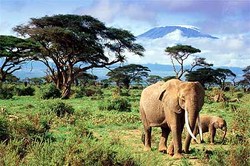 image from www.britannica.com
image from www.britannica.com
A habitat is an ecological or environmental area that is inhabited by human, a particular species of animal, plant, or other type of organism. A place where a living thing lives is its habitat. It is a place where it can find food, shelter, protection and mates for reproduction. It is the natural environment in which an organism lives, or the physical environment that surrounds a species population.
Be aware that for some organisms, habitats can change over time as a result of migration.
Be aware that for some organisms, habitats can change over time as a result of migration.
2.1.3U A niche describes the particular set of abiotic and biotic conditions and resources to which an organism or population responds
- Define niche with reference to a named example
- Distinguish between biotic and abiotic (physical) components of an ecosystem
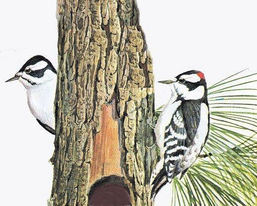 image from www.paulnoll.com
image from www.paulnoll.com
A niche describes the particular set of abiotic and biotic conditions and resources to which an organism or population responds.
Describes how an organism or population responds to the distribution of resources and competitors (for example, by growing when resources are abundant, and when predators, parasites and pathogens are scarce) and how it in turn alters those same factors (for example, limiting access to resources by other organisms, acting as a food source for predators and a consumer of prey).
Describes how an organism or population responds to the distribution of resources and competitors (for example, by growing when resources are abundant, and when predators, parasites and pathogens are scarce) and how it in turn alters those same factors (for example, limiting access to resources by other organisms, acting as a food source for predators and a consumer of prey).
2.1.U4 The fundamental niche describes the full range of conditions and resources in which a species could survive and reproduce. The realized niche describes the actual conditions and resources in which a species exists due to biotic interactions.
- Distinguish between fundamental and realized niche with reference to a named example
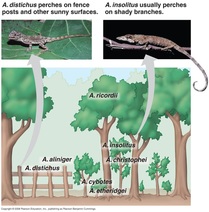
Every organism is adapted to environmental conditions in its habitat. However, it sometimes faces competition with other species that limits the conditions under which it can exist. Explore how competition between species can shape an organism's niche. The role that an organism plays in nature is called ecological niche. For an animal, that niche includes things like its behavior, the food it eats, and whether it is active at night or in the day.. Every organism, whether an apex predator like the lion or a bacterium living in a hippo's intestinal tract, is likely to face competition from other species.. This direct form of competition for an ecological niche is called interspecific competition.. This ideal niche that would exist in the absence of competition from other species is called a species' fundamental niche. However, organisms like the lion are generally forced to play a more limited role thanks to competition. The actual niche that a species fills in the face of interspecific competition is called its realized niche.
2.1.U5 The non-living, physical factors that influence the organisms and ecosystem - such as temperature, sunlight, pH, salinity and precipitation - are termed abiotic factors
- List the significant abiotic (physical) factors of an ecosystem.
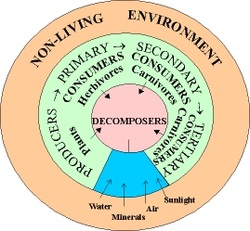
- Biotic: All the plants, animals, algae, fungi and microbes in an ecosystem.
- Abiotic: The chemical and physical factors in an ecosystem (non living) for example: temperature, moisture, salininty, soil type, light, air

Abiotic factors vary in the environment and determining the types and numbers of organisms that exist in that environment.
Factors which determine the types and numbers of organisms of a species in an ecosystem are called limiting factors. Many limiting factors restrict the growth of populations in nature. An example of this would include low annual average temperature average common to the Arctic restricts the growth of trees, as the subsoil is permanently frozen.
Factors which determine the types and numbers of organisms of a species in an ecosystem are called limiting factors. Many limiting factors restrict the growth of populations in nature. An example of this would include low annual average temperature average common to the Arctic restricts the growth of trees, as the subsoil is permanently frozen.
- soil temperature
- air temperature
- wind speed
- sunlight intensity
- soil nutrients
- water
- pH
2.1.U6 The interactions between the organisms - such as predation, herbivory, parasitism, mutualism, disease and competition - are termed biotic factors.
- Define population dynamics
- Distinguish between intraspecific competition and interspecific competition
- Describe competitive exclusion
- Define predation, herbivory, parasitism, mutualism, disease and competition with reference to named examples
- Distinguish a predator from a parasite
- Explain why competition for a resource has negative effects
Competition between members of the same species is Intraspecific competition. Individuals of the different species, competing for the same resources is called Interspecific competition.The other outcome is that one species may totally out compete the other, this is the principle of Competitive exclusion.
The word symbiosis literally means 'living together,' but when we use the word symbiosis in biology, what we're really talking about is a close, long-term interaction between two different species. There are many different types of symbiotic relationships that occur in nature.
The word symbiosis literally means 'living together,' but when we use the word symbiosis in biology, what we're really talking about is a close, long-term interaction between two different species. There are many different types of symbiotic relationships that occur in nature.
- predation - one species feeds on another which enhances fitness of predator but reduces fitness of prey. Herbivory is a form of predation.
- herbivory - the act of eating plants and a herbivore is an animal that eats plants. Herbivores play an important role in the ecology of any area, influencing plant communities and individual plant growth. A form of predation.
- parasitism - The host provides a habitat and food for the bacteria, but in return, the bacteria cause disease in the host. This is an example of parasitism or an association between two different species where the symbiont benefits and the host is harmed. Not all parasites have to cause disease.
- mutualism - A type of symbiotic relationship in which both species benefit from the relationship.
- disease - a particular abnormal condition, a disorder of a structure or function, that affects part or all of an organism. includes organisms such as viruses, bacteria, fungi and parasites that cause disease.
- competition - the relationship between species that attempt to use the same limited resource (e.g. hyenas fighting with lions over a carcass or trees competing for sunlight at the top of the canopy)
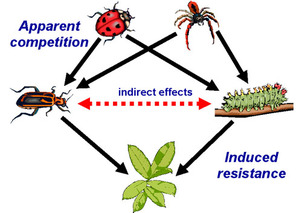
- commensalism – one species receives a benefit from another species which enhances fitness of one species; no effect on fitness of the other species.
- symbiosis - wo species live together which can include parasitism, mutualism, and commensalism..
2.1.U7 Interactions should be understood in terms of the influences each species has on the population dynamics of others, and upon the carrying capacity of the others environment.
- Distinguish between density-dependent and density independent factors
 image from www.geo.arizona.edu
image from www.geo.arizona.edu
A population is a collection of individual organisms of the same species that occupy some specific area. The term "population dynamics" refers to how the number of individuals in a population changes over time. Biologists study the interations that affect population dynamics. Understanding populations dynamics helps biologists understand the conservation of endangered species and management of fish and wildlife. Basic knowledge about the processes that affect population dynamics can be used to predict future patterns of human population growth.
The abundance of environmental resources such as food, water, and space determines how population abundance changes over time. In the presence of unlimited resources, populations grow exponentially.
The abundance of environmental resources such as food, water, and space determines how population abundance changes over time. In the presence of unlimited resources, populations grow exponentially.

Density-dependent factors:
Factors that lower the birth rate or raise the death rate as a population grows in size. They are negative feedback mechanisms leading to the stability or regulation of the population.
When prey increases so does the predator, but when this occurs the prey decreases and then again the predators decrease too causing the prey to increase again.
Density-independent factors:
Factors that affect a population irrespective of population density notably environmental change. Abiotic factors are density-independent factors, the most important ones are the extremes of weather (droughts, fires and hurricane) and long-term climate change.
These factors have an impact that can increase the death rate and reduce the birth rate, it all depends on how severe the event was.
Factors which regulate population size can be divided into either INTERNAL or EXTERNAL.
The major cause of population regulation are in the environments, these can be physical or biological.
The physical class of environmental factors are water availability, nutrient availability anf so on.
Biological factors include predators, and competition.
Ways humans can cause population growth:
Ways to decline population:
Factors that lower the birth rate or raise the death rate as a population grows in size. They are negative feedback mechanisms leading to the stability or regulation of the population.
When prey increases so does the predator, but when this occurs the prey decreases and then again the predators decrease too causing the prey to increase again.
Density-independent factors:
Factors that affect a population irrespective of population density notably environmental change. Abiotic factors are density-independent factors, the most important ones are the extremes of weather (droughts, fires and hurricane) and long-term climate change.
These factors have an impact that can increase the death rate and reduce the birth rate, it all depends on how severe the event was.
Factors which regulate population size can be divided into either INTERNAL or EXTERNAL.
- Internal: fertility rates, territory sizes
- External: predation, pressure, parasitism
The major cause of population regulation are in the environments, these can be physical or biological.
The physical class of environmental factors are water availability, nutrient availability anf so on.
Biological factors include predators, and competition.
Ways humans can cause population growth:
- increase available resources
- reduce competition
- reduce pressure from predators
- introduce animals to new areas
Ways to decline population:
- change environment, cause habitat disruption
- change the biological environment by introducing new species
- cause secondary extinctions
- overkill
2.1.U8 A population is a group of organisms of the same species living in the same area at the same time, and which are capable of interbreeding.
- Define population with reference to a named example
- State the factors that affect a population
 image from www.ieu.uzh.ch
image from www.ieu.uzh.ch
A population is a group of organisms of the same species living in the same area at the same time and capable of interbreeding. These species share a requirement for a limited resource which reduces fitness of one or both species.
Population density is the average numb er of individuals in a stated area.
Factors affecting population size are:
Population density is the average numb er of individuals in a stated area.
Factors affecting population size are:
- natality
- mortality
- migration (immigration or emigration)
2.1.U9 S and J population curves describe a generalized response of populations to a particular set of conditions (abiotic and biotic factors).
- Describe and explain S and J population curves.
- Identify environmental resistance
- Define carrying capacity
In an environment where resources become limited, populations exhibit a pattern of growth called logistic growth. In this case, if one plots the number of individuals in the population over time, one finds a sigmoidal, or S-shaped curve. When population abundance is low, the population grows exponentially. However, as population size increases, resources become limited, the population growth rate slows, and the population abundance curve flattens. The number of individuals present in the population when the growth rate slows to zero is referred to as K, the carrying capacity. The carrying capacity is the theoretical maximum number of individuals that the environment can support.
A "J" curve hits its carrying capacity and just continues causing a population explosion and competition for resources.
A population curve which shows only exponential growth. It starts slow the becomes increasingly fast.
A "J" curve hits its carrying capacity and just continues causing a population explosion and competition for resources.
A population curve which shows only exponential growth. It starts slow the becomes increasingly fast.
2.1.U10 Limiting factors will slow population growth as it approaches the carrying capacity of the system
- Explain the concepts of limiting factors and carrying capacity in the context of population growth
Carrying capacity is the maximum number of organisms that an area or ecosystem can sustainably support over a long period of time.vThere are however limiting factors including temperatures, water and nutrient availability. The main factors are temperature and water availability. Limiting factors are factors that limit the distribution or numbers of a particular population. Limiting factors are environmental factors which slow down population growth.
Temperature:
There are many ways the temperature can affect species. For example some seeds only grow in extremely high temperatures as it enriches the soil with nutrients and kills competition. However some are damaged if they are too warm or too cold. Some are able to survive low temperature. Animals adapt to the hot/ cold temperature either by burrowing under the ground to avoid heat or having cold blood in the heat.
Water:
All plants/animals need water to survive, for plants have no water could cause the plant to not germinate or seeds to die. No water = Death.
Temperature:
There are many ways the temperature can affect species. For example some seeds only grow in extremely high temperatures as it enriches the soil with nutrients and kills competition. However some are damaged if they are too warm or too cold. Some are able to survive low temperature. Animals adapt to the hot/ cold temperature either by burrowing under the ground to avoid heat or having cold blood in the heat.
Water:
All plants/animals need water to survive, for plants have no water could cause the plant to not germinate or seeds to die. No water = Death.
Application and Skills
2.1.A1 Explain population growth curves in terms of numbers and rates
 image from http://ibguides.com/biology/notes/populations
image from http://ibguides.com/biology/notes/populations
The sigmoid graph showing the population growth of a species has three phases which are; the exponential phase, the transitional phase and the plateau phase. At the start of the sigmoid curve we can see the exponential phase. This is where there is a rapid increase in population growth as natality rate exceeds mortality rate. The abundant resources available such as food for all members of the population and diseases as well as predators are rare. As time passes, the population reaches the transitional phase. This is where the natality rate starts to fall and/or the mortality rate starts to rise. It is the result of a decrease in the abundance of resources, and an increase in the number of predators and diseases. However, even though population growth has decreased compared to the exponential phase, it is still increasing as natality rate still exceeds mortality rate. Finally, the population reaches the plateau phase. Here, the population size is constant so no more growth is occurring. This is the result of natality rate being equal to mortality rate and is caused by resources becoming scarce as well as an increase in predators, diseases and parasites. These are the limiting factors to the population growth. If natality rate starts to drop then mortality rate will drop too as more resources become available. As natality rate starts to increase again so does mortality rate as resources become scarce. This keeps the population number relatively stable. If a population is limited by a shortage of resources then we say that it has reached the carrying capacity of the environment
2.1.S1 Interpret graphical representations or models of factors that affect an organism's niche. Examples include predator prey relationships, competition, and organism abundance over time
Key Terms
|
biotic
niche predation fresh water parasitism limiting factors S-curve fundamental niche abiotic factors biotic factors environmental resistance |
abiotic
preditor prey interspecific commensalism carrying capacity density effect realized niche interactions natality |
species
community parasitism terrestrial biosphere intraspecific ammensilism biotic potential r-selected mortality |
population
communities mutualism organisms predation neutralism intrinsic rate k-selected limiting factors interspecies |
habitat
ecology ecosystem immigration migration competition herbivory population density J-curve |
|
Click image for
Grassland Ecosystem |
Click image for
Marine Ecosystem |
Click image for Woodlands Ecosystem
|
Click image for Freshwater Ecosystem
|
Classroom Material
Exploring Species Activity
Species Interactions Activity
Carrying Capacity and Limiting Factor activity
Deer population graphing activity
Reindeer of St Matthew Data Activity
Carrying Capacity and Bears in Alaska activity
Symbiosis Class Activity
Population Dynamics reading - Annenberg Learner
Population Ecology Graph worksheet
Case Studies
Exploring Species Activity
Species Interactions Activity
Carrying Capacity and Limiting Factor activity
Deer population graphing activity
Reindeer of St Matthew Data Activity
Carrying Capacity and Bears in Alaska activity
Symbiosis Class Activity
Population Dynamics reading - Annenberg Learner
Population Ecology Graph worksheet
Case Studies
- Example of fundamental niche vs. realized niche
- Examples with named species of each of the following population interactions: predation, herbivory, parasitism, mutualism, disease, competition
Powerpoint and Notes Adapted from Brad Kremer, P Brooks and Ms. McCrindle
Your browser does not support viewing this document. Click here to download the document.
Your browser does not support viewing this document. Click here to download the document.
Correct use of terminology is a key skill in ESS. It is essential to use key terms correctly when communicating your understanding, particularly in assessments. Use the quizlet flashcards or other tools such as learn, scatter, space race, speller and test to help you master the vocabulary.
Useful Links
Nitche Science 2.1 Species and populations - Ecosystems Basics and Niches
Nitche Science 2.1 Species and populations - Population Changes
Nitche Science 2.1 Species and populations - Population Interactions
Fundamental Niche
Realized Niche
Assignment Discover Abiotic and Biotic - How Stuff Works
Abiotic Factors of a Coniferous Forest
Abiotic and Biotic Factors from Biology on Line
Abiotic Factors of Ecosystems - BBC Bitesize
Abiotic Tools - Educational Media Learning Centre
Predator and Prey Relationship - BBC Bitesize
Explore natural selection by controlling the environment and causing mutations in bunnies
In the News
World wildlife populations halved in 40 years - report - BBC News, 30 Sep 2014
Fast-growing fish species face greatest collapse risk - BBC News, 6 Aug 2015
TOK
- Through the use of specialized vocabulary, is the shaping of knowledge more dramatic in some areas of knowledge compared to others?
International-mindedness
- The change in one community can impact on other communities (butterfly effect)
Video Clips
Remarkable story of how the reintroduction of wolves to the Yellowstone National Park changed the ecology and habitat of the Park. There are many man-managed (or mismanaged) wildlife areas in the world missing predators.
Paul Andersen differentiates between biotic and abiotic factors. He explains how both abiotic and biotic factors can affect organisms at the level of the cell, the population and even the ecosystem. The complexities of biofilms, predator-prey relationships, and food webs are given as illustrative examples.
Species and populations
Paul Andersen explains the niche. He gives three different pronunciations and two different definitions. He then discusses the competitive exclusion principle and the idea that a niche cannot be shared by two species.
Hank brings us to the next level of ecological study with ecosystem ecology, which looks at how energy, nutrients, and materials are getting shuffled around within an ecosystem (a collection of living and nonliving things interacting in a specific place), and which basically comes down to who is eating who.
Interactions between species are what define ecological communities, and community ecology studies these interactions anywhere they take place. Although interspecies interactions are mostly competitive, competition is pretty dangerous, so a lot of interactions are actually about side-stepping direct competition and instead finding ways to divvy up resources to let species get along. Feel the love?
Symbiosis is close and often long-term interaction between different biological species. The definition of symbiosis is controversial among scientists. Some believe symbiosis should only refer to persistent mutualisms, while others believe it should apply to all types of persistent biological interactions (i.e. mutualistic, commensalistic, or parasitic).
Exploring Science Looks at Symbiosis, Mutualism, Commensalism, and Parasitism
Explore several ecological relationships with The Amoeba Sisters! Ecological relationships discussed include predation, competition, and symbiotic relationships (parasitism, mutualism, and commensalism
Different species often depend on one another. David Gonzales describes the remarkable relationship of the Clark's nutcracker and the whitebark pine, to illustrate the interdependency known as symbiosis.
Paul Andersen explains the differences between an r and a K selected species. He starts with a brief description of population growth noting the importance of; r or growth rate, N or number of individuals in the population, and K the carrying capacity. He describes three different survivorship curves found in organisms. He lists the characteristics of r-selected species like bacteria and K-selected species like humans.
